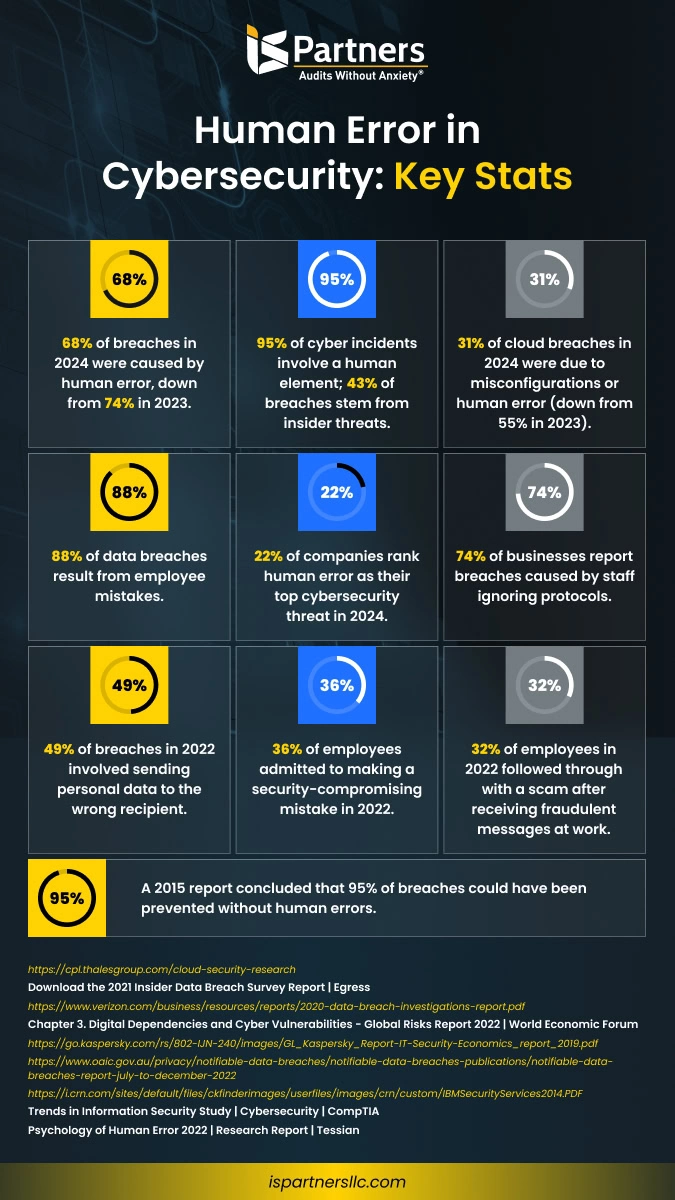
Human error in cybersecurity refers to unintentional actions by employees that compromise security, often due to negligence or poor decision-making. Common examples include falling for phishing scams, using weak passwords, or failing to update software. These errors are a major cause of data breaches, highlighting the need for better employee training and stronger security measures.
Human error in cybersecurity is a significant threat that manifests in various forms, each of which can compromise the security of sensitive data and systems. One common example is clicking on phishing links, where employees unintentionally provide sensitive information, such as login credentials, to malicious actors. Another form of human error is the use of weak or reused passwords, which are easily guessed or cracked by cyber criminals. Failure to follow essential security protocols, like not enabling multi-factor authentication (MFA), is also a major risk. Without MFA, accounts are more vulnerable to unauthorized access, especially if a password is compromised.
Additionally, mishandling sensitive information is another form of human error. This could involve accidentally sending confidential data to the wrong recipient, whether through email, text, or physical mail, or inadvertently leaving sensitive files exposed in a public space or on an unsecured network.
These types of mistakes can lead to significant breaches of privacy and financial losses for organizations.
To effectively minimize human error, it is crucial for companies to implement regular, consistent training programs that teach employees about cybersecurity best practices and the potential threats they may face.
These programs should not only focus on the technical aspects of security but also address the human behavior behind security risks, helping employees understand the potential consequences of their actions. Regular performance monitoring ensures that employees stay accountable for their actions, while also providing valuable feedback on areas for improvement.
Moreover, fostering a culture of accountability within the organization plays a key role in reducing the occurrence of human error.
When employees understand the importance of safeguarding sensitive information and are motivated to adhere to security protocols, they are more likely to be proactive about identifying and mitigating potential risks. Regular, targeted training from cybersecurity experts is essential in keeping staff updated on the latest threats and reinforcing secure practices.
By focusing on human behavior and creating a strong security-first mindset, organizations can significantly reduce the risks associated with human error and better protect their data and systems.
Key Statistics on Human Error in Cybersecurity
- 68% of breaches in a 2024 survey were due to human factors, like social engineering scams or mistakes. This was higher in 2023 at 74%.
- A survey found that 95% of cybersecurity issues have a human element, and 43% of breaches stem from insider threats (both accidental and intentional).
- 31% of cloud data breaches were attributed to misconfiguration or human error in 18 countries, rising to 55% in 2023.
- 22% of organizations identified human error as the biggest cybersecurity threat, with 74% considering it at least somewhat important.
- In 2021, 94% of businesses encountered insider data breaches, with 84% of IT leaders citing human error as the leading cause. However, only 21% considered it their top concern.
- Around 74% of organizations experienced breaches due to employees ignoring security protocols, and 73% faced breaches from phishing attacks.
- A 2019 report showed that “misuse of IT resources” was the most common cause of breaches, with 50% of small and medium businesses reporting these incidents.
- 49% of breaches in 2022 were due to personal information being sent to the wrong recipient.
- 33% of breaches involved the accidental disclosure or publication of personal data.
- A 2015 study found that human error contributed to over 95% of security incidents, with 19 out of 20 breaches prevented without human mistakes.
- Despite human error causing 52% of security breaches, only 30% of businesses viewed it as a major issue.
- A 2014 survey found that 42% of employees failed to adhere to policies, with 42% citing overall negligence and 31% unaware of new threats.
- 88% of data breaches in 2022 were due to employee mistakes.
- 36% of employees in a 2022 survey believed their actions put company security at risk, a reduction from 43% in 2020.
- 56% of employees in 2022 received fraudulent text messages at work, and 32% followed through, compromising company data.
These statistics emphasize the ongoing impact of human error on cybersecurity, highlighting the importance of training, awareness, and proactive measures to protect data.
I.S. Partners’ Infographic of Cybersecurity Services summarizes the human error in cybersecurity with the key statistics.


![The Construction Labor Shortage [Infographic] hero-image-addressing-the-construction-labor-shortage](https://www.skillzme.com/wp-content/uploads/2025/01/hero-image-addressing-the-construction-labor-shortage-200x200.jpg)
![Understanding the role of AI in Cyber Security [Infographic] hero-image-State-of-AI-Cybersecurity-2024](https://www.skillzme.com/wp-content/uploads/2024/11/hero-image-State-of-AI-Cybersecurity-2024-200x200.jpg)
![United Arab Emitaes (UAE) Population Statistics 2024 [Infographic] hero-image-UAE-Population-Statistics-2024](https://www.skillzme.com/wp-content/uploads/2024/11/hero-image-UAE-Population-Statistics-2024-200x200.jpg)


Recent Comments